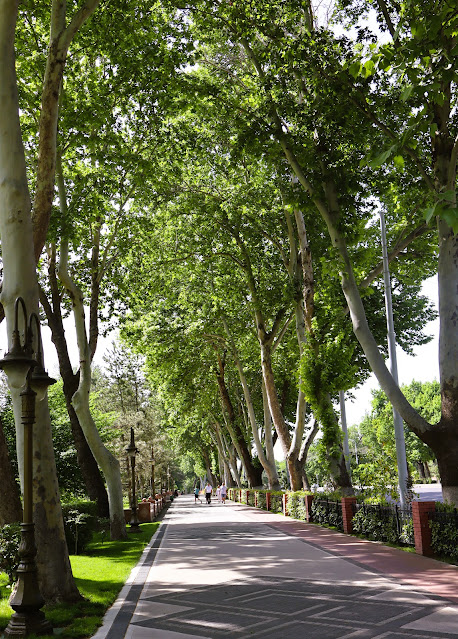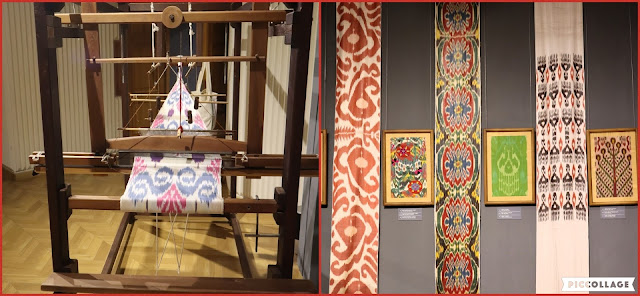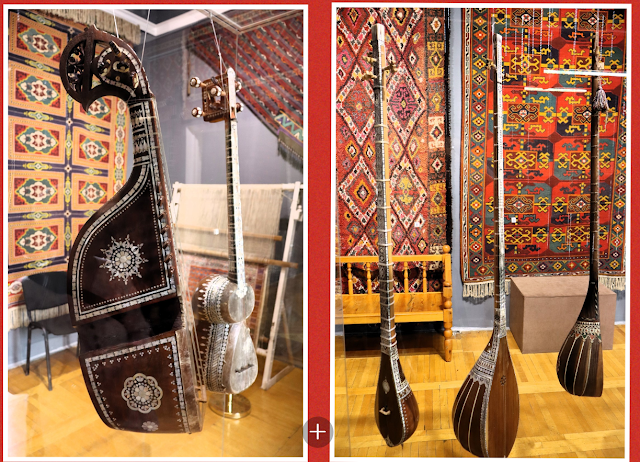Uzbekistan - The Journey
It's been long travels with some added delays. At 03:30 am and 36 hours since we left home we are glad to see the Uzbek sign on the airport and even happier to get into a taxi to whisk us to the hotel.The Uzbekistan flag also greets us.
The internet tells us that the blue colour on the flag is a symbol of the sky and of clear water. Azure is also the colour of the Turkic peoples. White is the traditional Uzbek symbol of peace and good luck, while green is a symbol of nature, new life, and good harvest.We both notice that the journey from the airport to the hotel seems kind of weird, twisting through what appears to be back alleys with little to no light. It's feeling a bit sketchy, but all is well and we are dropped off at the hotel.
Our little hotel has 14 rooms, and there are several like it in the neighbourhood. The hotel is basic, but clean and comfortable, and breakfast keeps us full until dinner time. Every morning, our breakfast includes pieces of round flatbread (made in a tandoor). This delicious bread has many meanings and some rules about how to eat it, and there are many types and styles of the round flatbread throughout the country. Below is the common one in Tashkent.
The staff patiently help us to download (and learn) new apps that replace Google Maps, which works poorly here and another that can be used to call a taxi.
Jet lag persists, and we sleep in until 10 am the next day, so we decide the only activity we will do is to ride the underground subway lines. We figure that the underground will get us in and out of the 37-degree heat that we are not yet used to. The metro stations also provide an excellent history of Uzbekistan, and they really are beautiful to see. Much has been written about them elsewhere, so will just share a few photos.
We are 'rural folk', not 'city folk', but even we found the metro station very easy to follow. Going from one line to another is easy and much of the city is covered.
Before seeing the stations, we needed a little synopsis of history to the present day. In the 14th and 15th centuries, Amir Timur was a courageous and fierce warrior who brought people and lands together. His love of the arts, science and education created a period of enlightenment, and he is celebrated still today.One metro station, a plaza and a museum are dedicated to this beloved hero. He was also instrumental in forming the trade routes of the Silk Road.
Uzbekistan came under Russian control in the 19th century and gained its independence in 1991.
Despite not being a democracy and despite 5% of the population living below the poverty line, in 2024, it was ranked as the happiest nation in Central Asia.
Today, Tashkent is a modern city in Uzbekistan with 3 million people, and it’s quite lovely. In all the walking we did, there were only two pieces of garbage anywhere around.
Three hundred thousand people were left homeless by the 1966 earthquake, but the government, since then, has been involved in identifying and providing shelter for citizens and thus, homeless people were not visible anywhere, camping on sidewalks and streets or needing to beg for survival.
Tashkent is full of many relaxing and beautiful large parks. Tashkent City park is new, modern, and so large that there are little electric vehicles that people can hop into to circumnavigate the park. We hope to see this park at night when we return in a week for a quick visit, as there are many interesting lights throughout it. The photo on the bottom right is a fountain that moves to music played in the background. You can see fountain heads and lights submerged. Many of the parks here have spectacular pools and fountains.

Even some of the sidewalks look like a park.
On the way to the nearest tram station, we cannot resist a stop at the Mirobod Market. The produce is so clean it sparkles, and everything from vegetables to eggs is artfully stacked. The scent of spices fills the air, and we are offered bits of dried fruit. Dried fruit and nuts are the favourite snacks here. Around the perimeter of the market are stores selling clothes, items from silk and the unique ceramics that the country is known for.
For just 6,000 UZS, we both could have ridden the trams all day, but every time we left a station, a new ticket was required. I think we did this five times, so 6,000 x 5 = 30,000 UZD (or ~ CAD 3.21), pretty inexpensive sightseeing. What we thought would be an easy day turned out to be 28,000+ steps thanks to the many beautiful parks and squares located above the metro stations that got us out and about. We saw just a few of the 48 stations and their above-ground surfaces.
While in another station, the flowering cotton plant is celebrated with representation in mosaic tiles.
As we walked through neighbourhoods with Botus, we just had to ask about these pipes that are everywhere, wondering if they were bringing water to homes. No, they are bringing gas for heating. This startled us as many seem to be in precarious places where they could be hit by a car, or some other misadventure. As we travelled through Uzbekistan, they were throughout the country.
Our last night in Tashkent is dinner at a Turkish restaurant. It's an amazing cavernous space with lovely brick architecture, beautifully decorated with preserves and all kinds of fruit, nuts and even aromatics hanging to dry; big gourds in baskets of straw; clothes and crafts from Turkey; and bright, flamboyant fish in tanks. If we had come about 9 pm, some Turkish dancers would do a show, then later invite the audience up to dance. The servers are all in traditional clothes. The last photo is of a table reserved for a big crowd on which the servers had just placed appetizers and bread.
Next stop is the Fergana Valley, then we will be back into Tashkent for a couple of days before flying north to Nukus.
MISCELLANEOUS PHOTOS





























































What a wonderful place to see! And through seasoned traveler eyes! Appreciated the historic notes along with the present colour and vitality of the city (and its foods!) Its people sound warm, welcoming and curious.
ReplyDeleteWe were worried that our lack of the Uzbek or Russian languages would be a real impediment, but nothing is when you want to communicate. The people here and in other countries like Albania, remind us always to move out of our 'North American' shell and to approach people, offer kindness and at least a warm greeting. Travel gives many lessons. Glad you enjoyed the post. Thanks for writing.
ReplyDeleteWe both love your post. The gardens are wonderful and the Turkish dinner looked great. What would be a typical price to pay for dinner?
ReplyDeleteHi - thanks for your question - For a good meal we would pay approx. 150,000 to 200,000 UZS which translates to $15.00- 20.00 CAD. for 2 persons, including a beverage. Last evening we bought street food which included a variety of great items for less than $ 5.00 CAD , including a beer. This was only our first stop, will be posting more soon. We encourage people to come and meet the lovely people here.
ReplyDelete